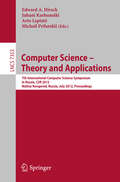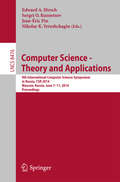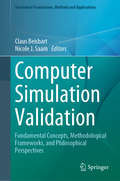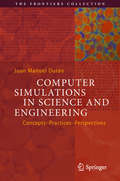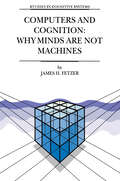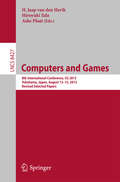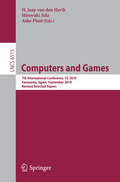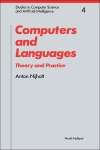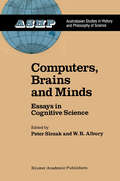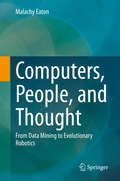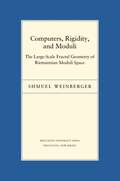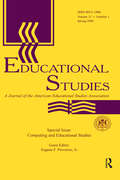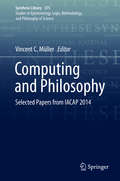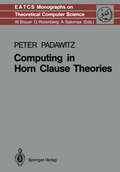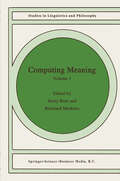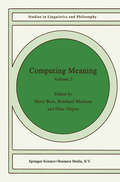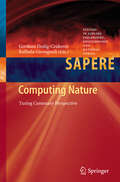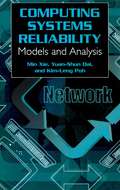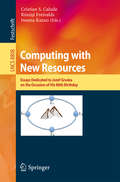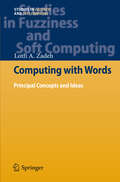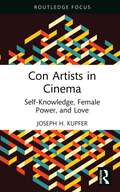- Table View
- List View
Computer Science -- Theory and Applications: 7th International Computer Science Symposium in Russia, CSR 2012, Niszhny Novgorod, Russia, July 3-7, 2012, Proceedings (Lecture Notes in Computer Science #7353)
by Edward Hirsch Juhani Karhumäki Arto Lepistö Michail PrilutskiiThis book constitutes the proceedings of the 7th International Computer Science Symposium in Russia, CSR 2012, held in Nizhny Novgorod in July 2012. The 28 full papers presented in this volume were carefully reviewed and selected from 66 submissions. CSR 2012 was one of the events of the Alan Turing Year 2012, the topics dealt with cover substantial parts of theoretical computer science and its applications.
Computer Science - Theory and Applications: 9th International Computer Science Symposium in Russia, CSR 2014, Moscow, Russia, June 7-11, 2014. Proceedings (Lecture Notes in Computer Science #8476)
by Edward Hirsch Sergei O. Kuznetsov Jean-Eric Pin Nikolay VereshchaginThis book constitutes the proceedings of the 9th International Computer Science Symposium in Russia, CSR 2014, held in Moscow, Russia, in June 2014. The 27 full papers presented in this volume were carefully reviewed and selected from 76 submissions. In addition the book contains 4 invited lectures. The scope of the proposed topics is quite broad and covers a wide range of areas in theoretical computer science and its applications.
Computer Simulation Validation: Fundamental Concepts, Methodological Frameworks, and Philosophical Perspectives (Simulation Foundations, Methods and Applications)
by Claus Beisbart Nicole J. SaamThis unique volume introduces and discusses the methods of validating computer simulations in scientific research. The core concepts, strategies, and techniques of validation are explained by an international team of pre-eminent authorities, drawing on expertise from various fields ranging from engineering and the physical sciences to the social sciences and history. The work also offers new and original philosophical perspectives on the validation of simulations.Topics and features: introduces the fundamental concepts and principles related to the validation of computer simulations, and examines philosophical frameworks for thinking about validation; provides an overview of the various strategies and techniques available for validating simulations, as well as the preparatory steps that have to be taken prior to validation; describes commonly used reference points and mathematical frameworks applicable to simulation validation; reviews the legal prescriptions, and the administrative and procedural activities related to simulation validation; presents examples of best practice that demonstrate how methods of validation are applied in various disciplines and with different types of simulation models; covers important practical challenges faced by simulation scientists when applying validation methods and techniques; offers a selection of general philosophical reflections that explore the significance of validation from a broader perspective.This truly interdisciplinary handbook will appeal to a broad audience, from professional scientists spanning all natural and social sciences, to young scholars new to research with computer simulations. Philosophers of science, and methodologists seeking to increase their understanding of simulation validation, will also find much to benefit from in the text.
Computer Simulations in Science and Engineering: Concepts - Practices - Perspectives (The Frontiers Collection)
by Juan Manuel DuránThis book addresses key conceptual issues relating to the modern scientific and engineering use of computer simulations. It analyses a broad set of questions, from the nature of computer simulations to their epistemological power, including the many scientific, social and ethics implications of using computer simulations. The book is written in an easily accessible narrative, one that weaves together philosophical questions and scientific technicalities. It will thus appeal equally to all academic scientists, engineers, and researchers in industry interested in questions (and conceivable answers) related to the general practice of computer simulations.
Computers and Cognition: Why Minds are not Machines (Studies in Cognitive Systems #25)
by J.H. FetzerAn important collection of studies providing a fresh and original perspective on the nature of mind, including thoughtful and detailed arguments that explain why the prevailing paradigm - the computational conception of language and mentality - can no longer be sustained. An alternative approach is advanced, inspired by the work of Charles S. Peirce, according to which minds are sign-using (or `semiotic') systems, which in turn generates distinctions between different kinds of minds and overcomes problems that burden more familiar alternatives. Unlike conceptions of minds as machines, this novel approach has obvious evolutionary implications, where differences in semiotic abilities tend to distinguish the species. From this point of view, the scope and limits of computer and AI systems can be more adequately appraised and alternative accounts of consciousness and cognition can be more thoroughly criticised. Readership: Intermediate and advanced students of computer science, AI, cognitive science, and all students of the philosophy of the mind.
Computers and Games: 8th International Conference, CG 2013, Yokohama, Japan, August 13-15, 2013, Revised Selected Papers (Lecture Notes in Computer Science #8427)
by H. Jaap Herik Hiroyuki Iida Aske PlaatThis book constitutes the thoroughly refereed post-conference proceedings of the 8th International Conference on Computers and Games, CG 2013, held in Yokohama, Japan, in August 2013, in conjunction with the 17th Computer and Games Tournament and the 20th World Computer-Chess Championship. The 21 papers presented were carefully reviewed and selected for inclusion in this book. They cover a wide range of topics which are grouped into five classes: Monte Carlo Tree Search and its enhancements; solving and searching; analysis of game characteristic; new approaches; and serious games.
Computers and Games: 7th International Conference, CG 2010, Kanazawa, Japan, September 24-26, 2010, Revised Selected Papers (Lecture Notes in Computer Science #6515)
by H. Jaap Van Den Herik Hiroyuki Iida Aske PlaatThis book constitutes the refereed proceedings of the 7th International Conference on Computers and Games, CG 2010, held in Kanazawa, Japan, in September 2010. The 24 papers presented were carefully reviewed and selected for inclusion in this book. They cover a wide range of topics such as monte-carlo tree search, proof-number search, UCT algorithm, scalability, parallelization, opening books, knowledge abstraction, solving games, consultation of players, multi-player games, extraversion, and combinatorial game theory. In addition a wide range of computer games is dealt with, such as Chinese Checkers, Chinese Chess, Connect6, Go, Havannah, Lines of Action, Pckomino, Shogi, Surakarta, and Yahtzee.
Computers and Languages: Theory and Practice (ISSN #Volume 4)
by A. NijholtA global introduction to language technology and the areas of computer science where language technology plays a role. Surveyed in this volume are issues related to the parsing problem in the fields of natural languages, programming languages, and formal languages.Throughout the book attention is paid to the social forces which influenced the development of the various topics. Also illustrated are the development of the theory of language analysis, its role in compiler construction, and its role in computer applications with a natural language interface between men and machine. Parts of the material in this book have been used in courses on computational linguistics, computers and society, and formal approaches to languages.
Computers, Brains and Minds: Essays in Cognitive Science (Studies in History and Philosophy of Science #7)
by P. Slezak W. R. AlburyThe institutionalization of History and Philosophy of Science as a distinct field of scholarly endeavour began comparatively early - though not always under that name - in the Australasian region. An initial lecturing appointment was made at the University of Melbourne imme diately after the Second World War, in 1946, and other appointments followed as the subject underwent an expansion during the 1950s and 1960s similar to that which took place in other parts of the world. Today there are major Departments at the University of Melbourne, the University of New South Wales and the University of Wollongong, and smaller groups active in many other parts of Australia and in New Zealand. "Australasian Studies in History and Philosophy of Science" aims to provide a distinctive publication outlet for Australian and New Zealand scholars working in the general area of history, philosophy and social studies of science. Each volume comprises a group of essays on a connected theme, edited by an Australian or a New Zealander with special expertise in that particular area. Papers address general issues, however, rather than local ones; parochial topics are avoided. Further more, though in each volume a majority of the contributors is from Australia or New Zealand, contributions from elsewhere are by no means ruled out. Quite the reverse, in fact - they are actively encour aged wherever appropriate to the balance of the volume in question.
Computers, People, and Thought: From Data Mining to Evolutionary Robotics
by Malachy EatonIn this book the author discusses synergies between computers and thought, related to the field of Artificial Intelligence; between people and thought, leading to questions of consciousness and our existence as humans; and between computers and people, leading to the recent remarkable advances in the field of humanoid robots. He then looks toward the implications of intelligent 'conscious' humanoid robots with superior intellects, able to operate in our human environments. After presenting the basic engineering components and supporting logic of computer systems, and giving an overview of the contributions of pioneering scientists in the domains of computing, logic, and robotics, in the core of the book the author examines the meaning of thought and intelligence in the context of specific tasks and successful AI approaches. In the final part of the book he introduces related societal and ethical implications.The book will be a useful accompanying text in courses on artificial intelligence, robotics, intelligent systems, games, and evolutionary computing. It will also be valuable for general readers and historians of technology.
Computers, Privacy and Data Protection: an Element of Choice
by Serge Gutwirth, Yves Poullet, Paul De Hert and Ronald LeenesThis timely interdisciplinary work on current developments in ICT and privacy/data protection, coincides as it does with the rethinking of the Data Protection Directive, the contentious debates on data sharing with the USA (SWIFT, PNR) and the judicial and political resistance against data retention. The authors of the contributions focus on particular and pertinent issues from the perspective of their different disciplines which range from the legal through sociology, surveillance studies and technology assessment, to computer sciences. Such issues include cutting-edge developments in the field of cloud computing, ambient intelligence and PETs; data retention, PNR-agreements, property in personal data and the right to personal identity; electronic road tolling, HIV-related information, criminal records and teenager's online conduct, to name but a few.
Computers, Rigidity, and Moduli: The Large-Scale Fractal Geometry of Riemannian Moduli Space (PDF)
by Shmuel WeinbergerThis book is the first to present a new area of mathematical research that combines topology, geometry, and logic. Shmuel Weinberger seeks to explain and illustrate the implications of the general principle, first emphasized by Alex Nabutovsky, that logical complexity engenders geometric complexity. He provides applications to the problem of closed geodesics, the theory of submanifolds, and the structure of the moduli space of isometry classes of Riemannian metrics with curvature bounds on a given manifold. Ultimately, geometric complexity of a moduli space forces functions defined on that space to have many critical points, and new results about the existence of extrema or equilibria follow. The main sort of algorithmic problem that arises is recognition: is the presented object equivalent to some standard one? If it is difficult to determine whether the problem is solvable, then the original object has doppelgängers--that is, other objects that are extremely difficult to distinguish from it. Many new questions emerge about the algorithmic nature of known geometric theorems, about "dichotomy problems," and about the metric entropy of moduli space. Weinberger studies them using tools from group theory, computability, differential geometry, and topology, all of which he explains before use. Since several examples are worked out, the overarching principles are set in a clear relief that goes beyond the details of any one problem.
Computers, Rigidity, and Moduli: The Large-Scale Fractal Geometry of Riemannian Moduli Space (Porter Lectures #20)
by Shmuel WeinbergerThis book is the first to present a new area of mathematical research that combines topology, geometry, and logic. Shmuel Weinberger seeks to explain and illustrate the implications of the general principle, first emphasized by Alex Nabutovsky, that logical complexity engenders geometric complexity. He provides applications to the problem of closed geodesics, the theory of submanifolds, and the structure of the moduli space of isometry classes of Riemannian metrics with curvature bounds on a given manifold. Ultimately, geometric complexity of a moduli space forces functions defined on that space to have many critical points, and new results about the existence of extrema or equilibria follow. The main sort of algorithmic problem that arises is recognition: is the presented object equivalent to some standard one? If it is difficult to determine whether the problem is solvable, then the original object has doppelgängers--that is, other objects that are extremely difficult to distinguish from it. Many new questions emerge about the algorithmic nature of known geometric theorems, about "dichotomy problems," and about the metric entropy of moduli space. Weinberger studies them using tools from group theory, computability, differential geometry, and topology, all of which he explains before use. Since several examples are worked out, the overarching principles are set in a clear relief that goes beyond the details of any one problem.
Computing and Combinatorics: 22nd International Conference, COCOON 2016, Ho Chi Minh City, Vietnam, August 2-4, 2016, Proceedings (Lecture Notes in Computer Science #9797)
by Thang N. Dinh My T. ThaiThis book constitutes the refereed proceedings of the 22nd International Conference on Computing and Combinatorics, COCOON 2016, held in Ho Chi Minh City, Vietnam, in August 2016. The 50 revised full papers papers presented in this book were carefully reviewed and selected from various submissions. The papers cover various topics including: Theory and Algorithms; Parameterized Complexity and Algorithms; Database and Data Structures; Computational Complexity; Approximation Algorithms; Cryptography; Network and Algorithms; Graph Theory and Algorithms; Computational Geometry; Scheduling Algorithms and Circuit Complexity; Computational Geometry and Computational Biology; and Logic, Algebra and Automata.
Computing and Educational Studies: A Special Issue of educational Studies
by Eugene F. ProvenzoThis special issue calls for a greater awareness of computing as a critical area of study for those interested in educational studies. Its purpose is to open up a wider dialogue about computing and education than has previously existed in the field. The questions raised provide the basis for a lively discussion and analysis of the role of educational studies in interpreting the role of computing in our culture and educational system. This issue also provides a model for exploring other topics of similar significance and importance to the field in future issues of the journal.
Computing and Educational Studies: A Special Issue of educational Studies (Counterpoints Ser. #123)
by Eugene F. Provenzo Jr.This special issue calls for a greater awareness of computing as a critical area of study for those interested in educational studies. Its purpose is to open up a wider dialogue about computing and education than has previously existed in the field. The questions raised provide the basis for a lively discussion and analysis of the role of educational studies in interpreting the role of computing in our culture and educational system. This issue also provides a model for exploring other topics of similar significance and importance to the field in future issues of the journal.
Computing and Philosophy: Selected Papers from IACAP 2014 (Synthese Library #375)
by Vincent C. MüllerThis volume offers very selected papers from the 2014 conference of the “International Association for Computing and Philosophy” (IACAP) - a conference tradition of 28 years. The theme of the papers is the two-way relation between computing technologies and philosophical questions: Computing technologies both raise new philosophical questions, and shed light on traditional philosophical problems. The chapters cover: 1) philosophy of computing, 2) philosophy of computer science & discovery, 3) philosophy of cognition & intelligence, 4) computing & society, and 5) ethics of computation.
Computing in Horn Clause Theories (Monographs in Theoretical Computer Science. An EATCS Series #16)
by Peter PadawitzAt least four research fields detennine the theoretical background of specification and deduction in computer science: recursion theory, automated theorem proving, abstract data types and tenn rewriting systems. As these areas approach each other more and more, the strong distinctions between functional and relational views, deductive and denotational approaches as well as between specification and programming are relieved in favour of their integration. The book will not expose the lines of this development; conversely, it starts out from the nucleus of Hom clause logic and brings forth both known and unknown results, most of which affect more than one of the fields mentioned above. Chapter 1 touches on historical issues of specification and prototyping and delimits the topics handled in this book from others which are at the core of related work. Chapter 2 provides the fundamental notions and notations needed for the presentation and interpretation of many-sorted Horn clause theories with equality. Chapter 3 supplies a number of sample Hom clause specifications ranging from arithmetic through string manipulation to higher data structures and interpreters of programming languages. Some of these examples serve as a reference to illustrate definitions and results, others may throw a light on the strong link between specifications and programs, which are executed by applying deduction rules. Thus we have included examples of how to use program trans/ormation methods in specification design.
Computing Meaning: Volume 1 (Studies in Linguistics and Philosophy #73)
by H. Bunt Reinhard MuskensThis book is a collection of papers written by outstanding researchers in the newly emerging field of computational semantics. It is aimed at those linguists, computer scientists, and logicians who want to know more about the algorithmic realization of meaning in natural language and about what is happening in this field of research. It includes a general introduction by the editors.
Computing Meaning: Volume 2 (Studies in Linguistics and Philosophy #77)
by Harry Bunt Reinhard Muskens Elias ThijsseThis book is a collection of papers written by outstanding researchers in the newly emerging field of computational semantics. Computational semantics is concerned with the computation of the meanings of linguistic objects such as text fragments, spoken dialogue utterances, and e-mail messages. The meaning of such an object is determined partly by linguistic information and partly by information from the context in which the object occurs. The information from these sources is combined by processes that infer which interpretation of the object applies in the given context. This applies not only to notoriously difficult aspects of interpreting linguistic objects, such as indexicals, anaphora, and metonymy, but also to establishing the precise reference of common nouns and the scopes of noun phrases. The central issue in computational semantics is how processes of finding and combining the relevant linguistic and contextual information into contextually appropriate meanings can be organised. Traditional approaches of applying context information to disambiguated natural language expressions do not work well, due to the massive ambiguity in natural language. Recent work in computational semantics suggests, alternatively, to represent linguistic semantic information in formal structures with underspecification, and to apply context information in inference processes that result in further specification of these representations. Underspecified representation and inference are therefore the key topics in this book. The book is aimed at those linguists, computer scientists, and logicians who take an interest in the computation of meaning, and who want to know what is happening in this exciting field of research.
Computing Nature: Turing Centenary Perspective (Studies in Applied Philosophy, Epistemology and Rational Ethics #7)
by Gordana Dodig-Crnkovic Raffaela GiovagnoliThis book is about nature considered as the totality of physical existence, the universe, and our present day attempts to understand it. If we see the universe as a network of networks of computational processes at many different levels of organization, what can we learn about physics, biology, cognition, social systems, and ecology expressed through interacting networks of elementary particles, atoms, molecules, cells, (and especially neurons when it comes to understanding of cognition and intelligence), organs, organisms and their ecologies? Regarding our computational models of natural phenomena Feynman famously wondered: “Why should it take an infinite amount of logic to figure out what one tiny piece of space/time is going to do?” Phenomena themselves occur so quickly and automatically in nature. Can we learn how to harness nature’s computational power as we harness its energy and materials? This volume includes a selection of contributions from the Symposium on Natural Computing/Unconventional Computing and Its Philosophical Significance, organized during the AISB/IACAP World Congress 2012, held in Birmingham, UK, on July 2-6, on the occasion of the centenary of Alan Turing’s birth. In this book, leading researchers investigated questions of computing nature by exploring various facets of computation as we find it in nature: relationships between different levels of computation, cognition with learning and intelligence, mathematical background, relationships to classical Turing computation and Turing’s ideas about computing nature - unorganized machines and morphogenesis. It addresses questions of information, representation and computation, interaction as communication, concurrency and agent models; in short this book presents natural computing and unconventional computing as extension of the idea of computation as symbol manipulation.
Computing System Reliability: Models and Analysis
by Min Xie Kim-Leng Poh Yuan-Shun DaiComputing systems are of growing importance because of their wide use in many areas including those in safety-critical systems. This book describes the basic models and approaches to the reliability analysis of such systems. An extensive review is provided and models are categorized into different types. Some Markov models are extended to the analysis of some specific computing systems such as combined software and hardware, imperfect debugging processes, failure correlation, multi-state systems, heterogeneous subsystems, etc. One of the aims of the presentation is that based on the sound analysis and simplicity of the approaches, the use of Markov models can be better implemented in the computing system reliability.
Computing with New Resources: Essays Dedicated to Jozef Gruska on the Occasion of His 80th Birthday (Lecture Notes in Computer Science #8808)
by Cristian S. Calude Rusins Freivalds Iwama KazuoProfessor Jozef Gruska is a well known computer scientist for his many and broad results. He was the father of theoretical computer science research in Czechoslovakia and among the first Slovak programmers in the early 1960s. Jozef Gruska introduced the descriptional complexity of grammars, automata, and languages, and is one of the pioneers of parallel (systolic) automata. His other main research interests include parallel systems and automata, as well as quantum information processing, transmission, and cryptography. He is co-founder of four regular series of conferences in informatics and two in quantum information processing and the Founding Chair (1989-96) of the IFIP Specialist Group on Foundations of Computer Science.
Computing with Words: Principal Concepts and Ideas (Studies in Fuzziness and Soft Computing #277)
by Lotfi A. ZadehIn essence, Computing with Words (CWW) is a system of computation in which the objects of computation are predominantly words, phrases and propositions drawn from a natural language. CWW is based on fuzzy logic. In science there is a deep-seated tradition of according much more respect to numbers than to words. In a fundamental way, CWW is a challenge to this tradition. What is not widely recognized is that, today, words are used in place of numbers in a wide variety of applications ranging from digital cameras and household appliances to fraud detection systems, biomedical instrumentation and subway trains. CWW offers a unique capability—the capability to precisiate natural language. Unprecisiated (raw) natural language cannot be computed with. A key concept which underlies precisiation of meaning is that of the meaning postulate: A proposition, p, is a restriction on the values which a variable, X—a variable which is implicit in p—is allowed to take. CWW has an important ramification for mathematics. Addition of the formalism of CWW to mathematics empowers mathematics to construct mathematical solutions of computational problems which are stated in a natural language. Traditional mathematics does not have this capability.
Con Artists in Cinema: Self-Knowledge, Female Power, and Love (Routledge Focus on Film Studies)
by Joseph H. KupferThis book examines the con artist film as a genre, exploring its main features while also addressing variations within it. The volume explores three diverse themes of the con artist film: edification, self-awareness, and liberation through con games; the femme fatale as con artist; and romantic love as a plot point. Analyzing movies such as Matchstick Men (2003), House of Games (1987), Body Heat (1981), The Last Seduction (1994), Birthday Girl (2001), and The Game (1997), the book also explores their psychological investigation of the con artist figure, the con artist’s mark, and how the dynamic between these roles implicates us as the audience. It also addresses the con artist film genre’s close association with neo-noir, especially through the femme fatale figure, investigating and updating the rich tradition of noir film. Demonstrating the range and flexibility of this understudied genre, this book will be of interest to scholars and students of film studies, ethics, and those studying the representation of women in film..
